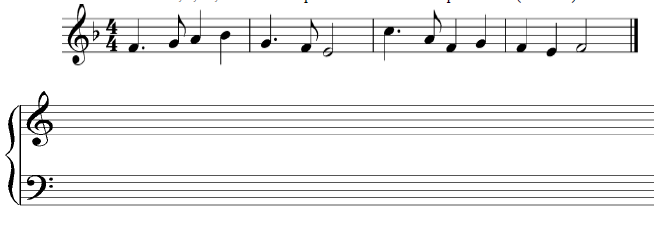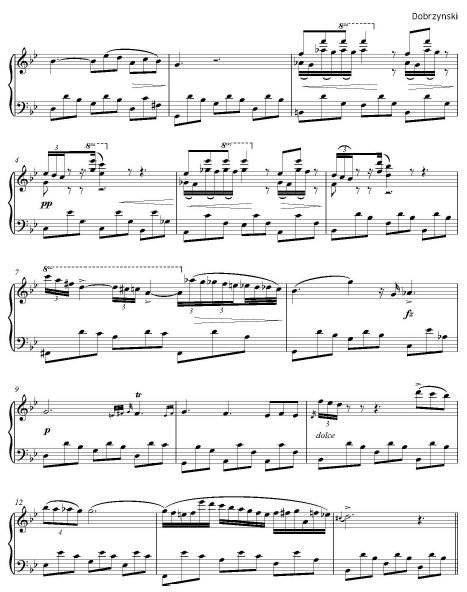SECTION A: BASIC SKILLS (30 marks)
Answer all questions in this section
- Melody
- Continue the given opening and compose a melody of sixteen bars for voice, modulating to the relative minor and returning to the tonic. Incorporate tempo variations and syncopation. Add phrase marks. (9 marks)
- Compose a melody and set to it the text given below. Use the treble stave a key of your choice. (6 marks)
Home for the holiday a break that I took,
The schools are opening I rush for my book.
- Continue the given opening and compose a melody of sixteen bars for voice, modulating to the relative minor and returning to the tonic. Incorporate tempo variations and syncopation. Add phrase marks. (9 marks)
- The following is the soprano melody. Harmonize the melody for SATB using appropriate chords from I, ii, IV, V and vi. Incorporate V7 at the cadential point. (15 marks)
SECTION B: HISTORY OF MUSIC (54 MARKS)
3. AFRICAN MUSIC
-
- What is a membranophone? (1 mark) ……………………………………
- State four techniques of pitch variation on traditional membranophones. (4 marks)
………………………
-
- Explain three reasons why culture plays an important role in defining an African traditional dance. (3 marks)
- Identify three aspects of a traditional African dance that determines its cultural idiom. (3 marks)
- Give three reasons why traditional African folk tunes are short and repetitive. (3 marks)
4. WESTERN MUSIC
- Thomas Morley
- Name one musical instrument for which Morley extensively composed. (1 mark)
- State six characteristic features of Morley’s madrigals. (6 marks)
- Domenico Scarlatti
- What medium is Scarlatti mainly associated with? (1 mark)
- Explain Scarlatti’s contribution to the development of music. (6 marks)
- Felix Mendelssohn
- What is a piano concerto? (1 mark)
- Give three examples of piano concertos by Mendelssohn. (3 marks)
- Describe Mendelssohn’s compositional style. (1 mark)
- Explain Mendelssohn’s contribution to the classical musical form. (2 marks)
- Vaughan William
- In which period of music history did Vaughan William compose? (1 mark)
- What type of work is each of the following by Vaughan William? (3 marks)
- The Wasps. …………
- The Poisoned Kiss. ……………………
- Old King Cole. ……………………
- State three ways in which the World War I influenced Vaughan William. (3 marks)
5. PRESCRIBED TRADITIONAL AFRICAN MUSIC
Siiriri From Folk Music of East Africa
- Describe the introductory section. (2 marks)
- Describe three characteristic features of the singing style in the main section. (3 marks)
- Outline two ways in which harmonic effect is achieved in the performance. (2 marks)
- Outline two roles of the percussion in the performance. (2 marks)
- Describe the ending. (1 mark)
6. PRESCRIBED WESTERN MUSIC
Septet Op. 20 – Movement 4 (Tema Con Variazioni) by Ludwig van Beethoven
- With reference to bar numbers explain the following terms. (3 marks)
- Theme
- Variation
- Coda
- Identify the most prevalent articulation mark used in the music. (½ mark)
- Describe the texture in the third variation (½ mark)
- Describe the parts in the woodwind section in bars 53 -54. (2 marks)
- With reference to bar numbers, identify any three compositional devices used in the fifth variation. (3 marks)
- Identify the chords in bar 120-124. (1 mark)
7. ANALYSIS OF UNPREPARED WORK
Look at the extract below and answer the questions which follow.
- Describe the meter of this extract. (1 mark)
- What type of scale is used on the last beat of bar 7? (1 mark)
- What is the key in the opening two bars? (1 mark)
- Write the bar 14 right hand how it will be performed. (1 mark)
- Describe the volume intensities in this extract. (1 mark)
- Name the style of accompaniment in the extract. (1 mark)
SECTION C: GENERAL MUSIC KNOWLEDGE (16 MARKS)
-
- Outline the four core functions of the Permanent Presidential Music Commission (PPMC) of Kenya. (4 marks)
- State three main features of the medieval plainsong. (3 marks)
-
- What is concert etiquette? (1 mark)
- Outline three ways to observe concert etiquette. (3 marks)
- Complete the table below with the correct information about the fugue form.
(5 marks)
Section Theme/Subject Key Exposition Development Recapitulation

MARKING SCHEME
-
-
- 16 bars 1 mark
- Modulation and back to the tonic 1 mark
- Syncopation 1 mark
- Tempo variations 1 mark
- Phrase marks 1 mark
- Lyricism 2 marks
- Melodic contour 1 mark
-
- Speech rhythm 4 marks
- Syllabic division 1 mark
- Lyricism 1 mark
- Melodic shape ½ mark
- Rhythmic variation ½ mark
-
-
- 14 chords 7 marks
- Cadences: (½ mark for each cadence). Total 1 mark
- Voice leading (½ marks for each voice). Total 1½ marks
- Voice range ½ mark
- Dominant seventh chord 1 mark
- Deduct 1 mark for each harmonic fault up to a maximum of 4 marks.
3. AFRICAN MUSIC
-
- An instrument which produces sound through vibration of a stretched skin membrane.
-
- Varying size of resonator.
- Varying playing technique.
- Tuning the drums differently.
- Use of different types of skin membrane
-
-
- Culture determines dance steps and styles
- Culture determines gender of the dance
- Culture determines occasions of dance performance
- Type of costume, colour of the costume and décor, dance styles
-
-
- For emphasis of the message
- For easy memorability since are not written down
- Melodic passages are shared between soloist and choir
4.
-
- Keyboard
-
- Were based on Church modes
- Were in free rhythm i.e. no bar lines
- Were secular in nature
- Were unaccompanied choral compositions
- Were highly imitative
- Were light, quick moving and easily singable.
-
- Keyboard
-
- Composed 555 sonatas e.g. the cat’s fugue
- Composed several choral music such as Stabat mater, salve Regine, oratorios, cantatas e.t.c.
- Composed symphonies
-
- Piano concerto – Instrumental composition for piano and orchestra.
-
- Rondo brillante
- Capriccio brillante
- Serenade
- Allegro giocoso
- His work shows an institutive command of form, harmony, counter-point, colour and compositional techniques.
- He changed the structural balance of the formal components of the classical movement. Thus in his movement, the development-recapitulation transition might not be strongly marked, and the recapitulation section would be harmonically or melodically varied so as not to be a direct copy of the opening, exposition, section; this allowed a logical movement towards a final climax.
-
- 20th Century
-
- Wasps – Overture
- The Poisoned Kiss – Opera
- Old King Cole – Ballet
-
- He stopped writing music
- The continual noise of the guns damaged his hearing and led to deafness in his later years.
- After war, he returned to civilian life and took sometimes before feeling ready to compose new works.
5. Analysis of Prescribed African Music
-
- The siiriri (fiddles) is the first to sound,
- followed by the chimbengele (struck idiophone)
- and then the chisasi (rattles or shaken idiophone).
- Talking by a man ½ mark each = 2marks
-
- ✔ It is solo voice
- ✔ It is chant like
- ✔ It is repetitive
- ✔ It is in call and response style with the fiddles 1 mark each = 3 marks
-
- ✔ Two fiddles playing at the same time
- ✔ Singing along as the instruments play 1 mark each = 2 marks
-
- ✔ To provide rhythmic accompaniment
- ✔ To sustain rhythm
- ✔ To keep time/pace/tempo 1 mark each = 2marks
- ✔ The music fades away/off 1 mark
6. Prescribed Western Music
Septet Op. 20 – Movement 4 (Tema Con Variazioni) by Ludwig van Beethoven
- With reference to bar numbers explain the following terms. (3 marks)
- Theme - A melodic figure or phrase that is the basis for a composition or a section of a composition. Bars 1-16
- Variation is a formal technique where material is repeated in an altered form.
- A coda is a passage that brings a piece (or a movement) to an end.
- staccato (½ mark)
- polyphonic/contrapuntal texture (½ mark)
- They are moving in arpeggios 1 mark
One is the inversion of the other (they move in contrary motion 1 mark -
- pedal note in viola bars 97 - 112
- terraced dynamics f at bar 10 and p in bar 108
- imitation between bassoon and clarinet bar 105 – 108
- unison in cello and bassoon parts bars 101-104
- arpeggios in violin bar 104
- V – I – V – I – V-V-V-V
7. Analysis of Unprepared Work
- compound triple meter 9 8
- Chromatic scale
- G minor
- It played softly
- Alberti bass
SECTION C: GENERAL MUSIC KNOWLEDGE (16 MARKS)
8.
- Functions of PPMC
- Guiding, coordinating and regulating music and dance activities in the country.
- Identification, nurturing, promotion and development of music and dance talents
- Documentation, conservation, preservation and dissemination of the music and dance heritage of Kenya.
- Preparation and presentation of entertainment during national days, state and other public functions.
- Provision of consultancy services in the field of music and dance.
-
- it is monophonic in texture (sang in unison)
- it has sacred text
- it is melismatic
- sung a cappella
- sung in Latin
- non-metric
- composed in modes, or modal
-
- Concert etiquette refers to a set of social norms observed by those attending musical performances.
-
- ✔ Clapping is the appropriate way to show appreciation for the performance rather than whistling or cheering.
- ✔ Enter the auditorium quietly. Once you have been seated, be alert to activity on the stage as the musicians take their place for the concert.
- ✔ When the conductor enters, it is customary to applaud politely. Whistling, yelling, or screaming is not appropriate at any time before, during, or after a concert.
- ✔ Never stand or move around while music is being performed. It distracts listeners around you, as well as the performers. If you must leave for any reason, wait until a piece is finished, and the audience is applauding.
- ✔ Also, return to your seat only between numbers.
- ✔ It is impolite to talk, or even whisper, while the music is being performed. Listeners and performers are also distracted by sounds from programs, candy wrappers, jewelry and other objects. Remain still, and be thoughtful of others by talking or making sounds only between numbers.
- ✔ It is impolite to wear hats or caps during a concert.
- ✔ It is impolite to eat or drink refreshments during a concert.
- ✔ Always say “excuse me,” if you must pass in front of someone while going to or from your seat.
- ✔ Watch the conductor when the music stops to decide whether or not to applaud. Some musical works have several parts or movements and the audience is expected to applaud only after all movements have been performed.
- ✔ Make certain that all pagers and cellphones are turned off prior to the start of any concert
-
Section Theme/Subject Key Exposition 1st subject Tonic key 2nd subject Related key (dominant/relative minor/major) Development 1st and 2nd subjects Modulations to different related keys Recapitulation 1st subject Tonic key 2nd subject Tonic key
Download Music Paper 3 Questions and Answers - Kapsabet Mocks 2020/2021.
Tap Here to Download for 50/-
Get on WhatsApp for 50/-
Why download?
- ✔ To read offline at any time.
- ✔ To Print at your convenience
- ✔ Share Easily with Friends / Students




